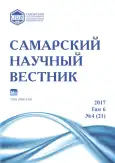Red wood ants (Hymenoptera, Formicidae) influence on the spatial distribution of small mammals in the conditions of the Volga Upland
- Authors: Boryakova E.E.1, Melnik S.A.1
-
Affiliations:
- National Research Lobachevsky State University of Nizhny Novgorod
- Issue: Vol 6, No 4 (2017)
- Pages: 18-23
- Section: 03.02.00 – General Biology
- URL: https://journals.rcsi.science/2309-4370/article/view/22224
- DOI: https://doi.org/10.17816/snv201764103
- ID: 22224
Cite item
Full Text
Abstract
The paper presents the results of research devoted to the study of the spatial interaction of small mammals and red wood ants. The aim of the research was to learn the ants Formica aquilonia Yarr. (Hymenoptera, Formicidae) influence on the spatial structure of Micromammalia populations in the Conifer-Deciduous Forests of the Volga Upland. Trapping of mammals was carried out with traps Gero, geobotanical descriptions were made according to standard methods; the package Statistica 6.0 was used for results processing. It was revealed that mouse-like rodents did not avoid ant-trails despite the fact of the ants disturbance factor. It’s presumably due to vegetation in the vicinity to anthills, the climate and the conditions created with the plants. The obtained results by the distribution of micromammalia burrows in the space allow us to speak about 2 groups of small mammals with different ecological strategy: «gravitating» which is near the ant-trails and anthills and «careful» which settle over a distance. The group «core» are probably individuals of the dominant species such as bank vole (Cletrionomys glareolus) and pygmy field mouse (Apodemus uralensis). The interaction of small mammals and ants in the mixed forests of the Volga Upland are mediated, apparently, with the influence of vegetation.
Full Text
##article.viewOnOriginalSite##About the authors
Elena Evgenievna Boryakova
National Research Lobachevsky State University of Nizhny Novgorod
Author for correspondence.
Email: boryakova@mail.ru
candidate of biological sciences, associate professor of Botany and Zoology Department
Russian Federation, Nizhny NovgorodSvetlana Anatolievna Melnik
National Research Lobachevsky State University of Nizhny Novgorod
Email: s_melnik72@mail.ru
candidate of biological sciences, associate professor of Botany and Zoology Department
Russian Federation, Nizhny NovgorodReferences
- Larsen A.L., Homyack J.A., Wigley T.B. et al. Effects of habitat modification on cotton rat population dynamics and rodent community structure // Forest Ecology and Management. 2016. Vol. 376. P. 238-246.
- Romero G.Q., Gonçalves-Souza T., Vieira C., Koricheva J. Ecosystem engineering effects on species diversity across ecosystems: a meta-analysis // Biological Reviews. 2015. Vol. 90, Iss. 3. P. 877-890.
- Длусский Г.М. Муравьи рода Формика. М.: Наука, 1967. 236 с.
- Ellenberg H., Weber H., Düll R., Wirth W., Werner W., Paulißen D. Zeigerwerte von Pflanzen in Mitteleuropa. 2nd ed. Scr. Geobot. 1992. Vol. 18. P. 1-258.
- Боряков И.В., Воротников В.П., Борякова Е.Е. Использование информационных технологий для организации фитоценариев и обработки геоботанических данных // Бот. Журнал. 2005. Т. 90, № 1. С. 95-104.
- Гланц С. Медико-биологическая статистика. М.: Практика, 1999. 460 с.
- Борякова Е.Е., Кочетков И.Б. Применение метода главных компонент для анализа зоологических данных // Актуальные вопросы современной науки: сборник научных трудов. Вып. 3. Новосибирск, 2009. С. 10-15.
- Трухачева Н.В. Математическая статистика в медико-биологических исследованиях с применением пакета Statistica. М.: ГЭОТАР-Медиа, 2012. 384 с.
- Коноплева Е.Е. Структура и динамика комплекса муравейников северного лесного муравья Formica aquilonia (Hymenoptera, Formicidae) в разных лесорастительных условиях // Вестник Нижегородского университета им. Н.И. Лобачевского, 2010. № 2 (2). С. 407-412.
- Зрянин В.А., Новоселова Н.А. Пригнездовые группировки растительности, складывающиеся под влиянием рыжих лесных муравьев (Hymenoptera, Formicidae) // Біорізноманіття та роль зооценозу в природних і антропогенних екосистемах: матеріали ІІ Міжнародної наукової конференції. Дніпропетровськ: ДНУ, 2003. С. 111-113.
- Зрянин В.А., Новоселова Н.А., Петрушова Е.С. Анализ растительных группировок вокруг муравейников рыжих лесных муравьев (Hymenoptera, Formicidae) // Поволжский экологический журнал, 2004, № 1. С. 48-51.
- Panteleeva S., Vygonyailova O., Reznikova Zh. Red wood ants as a perilous temptation for small rodents // 4th Central European Workshop of Myrmecology. Cluj-Napoca, Romania, 2011. P. 61.
- Башенина Н.В. Пути адаптаций мышевидных грызунов. М.: Наука, 1977. 354 с.
- Vorobyeva N., Vygonyailova O., Reznikova Zh., Panteleeva S. First count, then hunt: cognitive aspects of ant-hunting in the field striped mouse Apodemus agrarius Pallas. ECBB VI. European Conference on Behavioural Biology. Essen, Germany, 2012. P. 122.
- Brown J.H., Davidson D.W. Rodent seed-foraging strategies and competition with ants in the Sonoran Desert // U.S. International Biological Program, Desert Biome, Utah State University, Logan, Utah. Final Progress Reports, 1979. Process Studies, RM. P. 52-55.
- James H.B. Interactions between Rodents and Ants in the Chihuahuan Desert: An Update // The Ecological Society of America. 1994. № 75 (1). Р. 252-255.
- Быкова И.В., Яковлев И.К., Дорошева Е.А., Выгоняйлова О.Б. Предварительные данные о влиянии рыжих лесных муравьев на численность и пространственное распределение мелких грызунов // Муравьи и защита леса: мат-лы XIII всерос. мирмекологического симпозиума. Н. Новгород, 2009. С. 49-51.
- Пантелеева С.Н., Резникова Ж.И., Выгоняйлова О.Б. Полевые исследования пространственно-этологического взаимодействия мелких млекопитающих с рыжими лесными муравьями // Териофауна России и сопредельных территорий: мат-лы междунар. совещ. Х Съезда Териологического общества при РАН. М.: Товарищество науч. изданий КМК, 2016. С. 316.
- Buehlmann C., Grahamb P., Hanssona B.S., Knadena M. Desert ants use olfactory scenes for navigation // Animal Behaviour. 2015. Vol. 106. P. 99-105.
- Vega C. de, Herrera C.M., Dötterl S. Floral volatiles play a key role in specialized ant pollination // Perspectives in Plant Ecology, Evolution and Systematics. 2014. Vol. 16, Iss. 1. P. 32-42.








